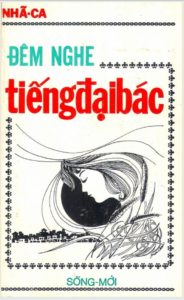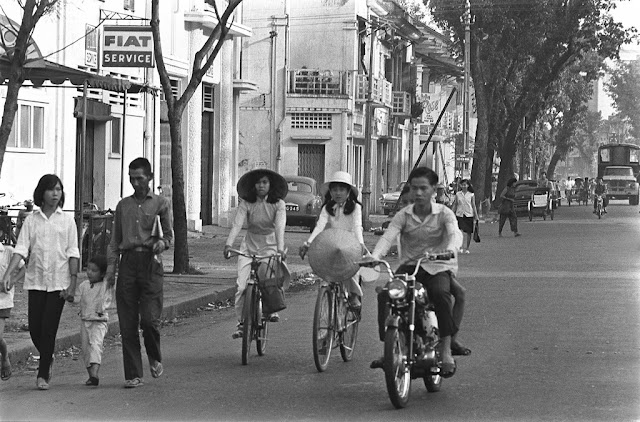Nhã Ca’s At Night I Hear the Cannons (Đêm nghe tiếng đại bác, 1966) poignantly captures the moment when the Vietnam War began encroaching on civilian life in Saigon. Set in the mid-1960s, the novel centers on a northern Vietnamese family of modest means who emigrated to Saigon when the country was divided a decade earlier. The narrator is Quyên, a teenage girl in secondary school and the next to youngest child in the family. At the start of the novel, Quyên’s mother wins a small sum from the national lottery, and the family eagerly makes plans for spending their unexpected windfall. Eventually, they decide to prepare a delicious meal with egg rolls for Quyên’s older brother Phan and his friend Nghĩa the next time the two young men visit. Both Phan and Nghĩa are soldiers serving in the Central Highlands, and Nghĩa is also the boyfriend of Quyên’s older sister Phương. The family expects the young men to be given leave soon.
The author presents Quyên’s life as an island of peace and normalcy in a sea of war, but the violence is slowly eroding the edges of her previously tranquil existence. Her days are filled with household chores, outings with her boyfriend, reading serialized novels, and other mundane activities of urban teenage life. But there are reminders of war all around her, and her brother Phan and prospective brother-in-law Nghĩa are never far from her mind. The man who exchanges her mother’s winning lottery ticket is a disabled veteran, and his disfigurement seems like a warning of the fate that may await the soldiers in her life. Trucks full of young recruits pass her on the street, and their fresh faces make her miss her brother and inspires a surge of tenderness in her heart for the soldiers. At night, she listens to the sound of cannons in the distant countryside and wonders if her loved ones are safe. She cannot help but feel anxious about her boyfriend, who will be drafted if he does not pass his exams. Meanwhile, her mother repeatedly postpones the much anticipated meal as the family waits and waits for Phan and Nghĩa to visit. When will they return?

At Night I Hear the Cannons is a snapshot of the early escalation of the Vietnam War from the perspective of a Saigon teenager who has only known peace. Quyên is also too young to have directly experienced the Resistance War (Kháng Chiến Chống Pháp, 1945-1954), Vietnam’s war of independence from France, though she has heard stories from her parents and older siblings about their wartime experiences in northern Vietnam. (The same conflict is known in the West as First Indochina War with a slightly different starting point of 1946.) Fighting restarted in the southern countryside during Quyên’s childhood in late 1950s, but the cities remained safe and quiet, and families like Quyên’s were largely spared. But the escalation of the war in the mid-1960s and the drafting of her older brother pierces the bubble of peace and innocence that surrounded her, just as it does for many other Saigon families. It is now her turn to encounter and endure war just as her parents and older siblings already have.
For Quyên’s parents and other northern migrants, the escalation of the Vietnam War evokes terrible memories of the earlier Resistance War. Many northern émigrés believed that they would find in southern Vietnam a permanent refuge from war, violence, and communism. As an elderly émigré woman laments to Quyên and her boyfriend, “I thought that if we came down here, my children and I could live in peace. We didn’t think he [the émigré’s son] would have to go fight the enemy.” Referring to Vietnamese communists obliquely as “they,” the woman continues, “If they come down here too, where would we flee?” (“Tôi tưởng vào đây mẹ con sống yên, ai ngờ nó phải đi lính đánh giặc. Rồi họ vào đây mình biết chạy đâu?”: Nhã Ca 84). If the southern migrants in Bình Nguyên Lộc’s Thoroughfare do not know if they will ever find a permanent home, the northern émigrés in Nhã Ca’s At Night I Hear the Cannons wonder if any place will ever truly be safe.
There is a plot twist in the novel that reminded me of a strikingly similar situation among my relatives. I won’t give away the surprise, but I will explain the story about my family that I heard from my cousins. In a particular branch of my relatives, the eldest son of the family died in the war, and his grieving mother and siblings were shocked to learn after his death that not only had he been in love but that his girlfriend was pregnant with his child. The young woman tried to commit suicide when she learned of his fate, but she fortunately survived and later gave birth to a healthy baby girl. My relatives welcomed mother and child with open arms. I met his granddaughter by this girlfriend during one my visits to Vietnam. I imagine that such occurrences must have been common enough during the war, but I was still shocked that a fictional incident so closely coincided with an event in the history of my extended family.
THE TECHNICAL STUFF
Note for readers: Nhã Ca’s At Night I Hear the Cannons is available in English. James Banerian’s translation came out in 1993 and is out of print but is available at a few university libraries. You can find the digitized version of the Vietnamese original online on several different websites, including this one: https://vietmessenger.com/books/?title=ddem%20nghe%20tieng%20dai%20bac.
Note for researchers: This novel would be great for scholars interested in civilian life, youth, and urban popular culture (especially soccer and martial arts novels). Olga Dror’s translation of Nhã Ca’s Mourning Headband for Huế includes a short biography of Nhã Ca.
The version I read: Nhã Ca. Đêm nghe tiếng đại bác. Reprint ed.Fort Smith, AK: Sống Mới, [1983?].
Photo credit: The image linked to this post showing young women riding bicycles in Saigon in the mid-1960s is by French journalist and photographer François Sully. I found the image here: https://www.vintag.es/2015/11/rare-vintage-photos-of-life-in-saigon.html.

